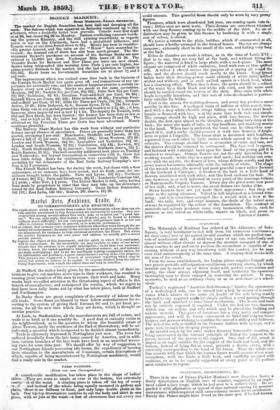FAILIS FASHIONS.
(From our own Correspondent.)
A considerable modification has taken place in the shape of ladies skirts. They are worn as ample as ever at the bottom, but extremely contra- d at the waist. A slanting piece is taken off the top of every 1.7 and instead of the whole being equally mounted in gathers and plaits, there is no fullness in front, and only large double plaits at the back. Our tip-top dressmakers contrive to cut the body and skirt in one piece, with no join at the waist—a feat of cleverness that not every one could execute. This graceful dress should only be worn by very pretty-
figure& Flounces, which were abandoned last year, are coming again into fa-
vour; littler ones arc most worn. Plain dresses are sometimes trimmed with one deep flounce coming up to the middle of tha skirt. Au air of distinction may be given to this flounce by bordering it with a single row of velvet, 3 cheval.
We notice a return to the plain boddiee, which if ornamented at all, should have a berthe arranged in the form of braces. Sleeves are always immense; extremely short in the small of the arm, and falling very laeg at the back.
Robes de ehambre are made A rideau, as in the timo of Louis XVI. ; that is to say, they are very full at the back, and without fitting the figure ; the material is fixed in large plaits with a neck-piece. The most elegant are composed of white cashmere, lined with rose or blue quitted silk. A velvet it cheval serves the purpose of a piping all rooprd the robe, and the sleeves should reach nearly to the knees. Some' lid ladies have their dressing-gowns made entirely of white satin,l'in ilted within and without, and in each quilted square is a black bead, which has a charming effect. When this is done, the gown should be confined at the waist by a thick black and white silk cord, and the same cord should be carried round the bottom of the skirt. Blue satin with white beads is equally luxurious, and this sort of robe-de-chambre is particu- larly suitable for brides. Lent is the season for wedding-dresses, and every day produces seine novelty in this line. A scolloped tunic of taffetas or white moire, trim- med with a deep white chenille fringe falling over a lower skirt bond- lonnee or flounced with lace, is at the same time both rich and simple. The corsage should be high and plain, with lace braces ; the sleeves double, the first open almost to the shoulder, and falling very deep at the back; the inner one made of tulle, in tiny bouillons, and reaching nearly to the hand. When lace is preferred, the tunic can be altogether com- posed of it, and a ruche should connect it with two flounces d'Angle- terre or point it l'aiguille. The lower skirt is decorated with bouillons, separated front each other by little ruches which ascend in the form of columns. The corsage should have a stomacher of ruche and lace, and the sleeves should be trimmed to correspond. The lace veil is square, and fastened with a straight band upon the bead of the young girl it is destined to envelope. Orange flowers are not the only favourites for a wedding wreath : white lilac is a great deal used ; but nothing can com- pete with the myrtle, the flower of love, whose delicate corolla and dark green leaves harmonize admirably with the toilette of white. The shape of the wreath varies; the newest and moat graceful comes rather forward on the forehead a ('antique; it finishes at the back in a little hood of flowers, interlaced with each other, and this head encloses the hair. No one, however, is so well informed on every point of the marriage toilette as Mademoiselle Virginie Vasseur. Every day she gives some new proof of her skill ; and, what is more, she never dresses two brides alike.
Straw bonnets have not yet made their appearance ; but they will come as the spring advances. Velvet is still employed as a bonnet trim- ming; and it is sometimes arranged like a wreath with a bow at the bacZ.. On tulle, lace, and crape bonnets, the shade of the velvet must always be regulated by the colour of the foundation. The contrast of materials and colours produces some very harmonious effects, such for instance as red velvet on white tulle, mauve on black, and green on


































 Previous page
Previous page